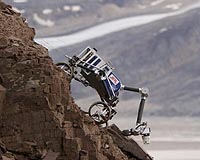 |
Cape Canaveral FL (SPX) Jun 12, 2009 NASA's Constellation Program reached two major processing milestones this week as two new pieces of Ares I-X hardware were transferred for final assembly in preparation for the first flight test of the rocket later this summer at NASA's Kennedy Space Center in Florida. Once stacking operations begin later this month, it will be the first time a new vehicle has been stacked on NASA's Mobile Launch Platform in more than 25 years. The forward assembly, composed of the forward skirt, forward skirt extension and the frustum, was moved Thursday from Kennedy's Assembly Refurbishment Facility, or ARF, to the Vehicle Assembly Building for stacking operations. The aft skirt was moved Monday from the ARF to the Rotation Processing and Surge Facility to be attached to the aft motor segment, forming the aft assembly. The assembly will next move to the Vehicle Assembly Building for stacking on the Mobile Launcher Platform. The Ares I-X rocket is a combination of existing and simulator hardware that will resemble the Ares I crew launch vehicle in size, shape and weight. It will provide valuable flight data to guide the final design of the Ares I, which will launch astronauts in the Orion crew exploration vehicle. "This is a very exciting week for the team to have the hardware moving out of the ARF, showing how much progress we've made and that we are that much closer to launch," said NASA Ares I-X mission manager Bob Ess of NASA's Johnson Space Center in Houston. The flight test of the Ares I-X will bring NASA one-step closer to its Constellation Program's exploration goals of returning humans to the moon for sustained exploration of the lunar surface and missions to destinations beyond. The forward assembly connects the 12-foot diameter first stage motor to the 18-foot diameter upper stage simulator. Weighing more than 40,000 pounds, the assembly houses three newly designed descent parachutes for first stage recovery. The aft skirt, which is used at the bottom of the Solid Rocket Boosters for the Space Shuttle Program, was modified over the last year and a half for use on Ares I-X. Some modifications include adding deceleration and tumble motors, avionics and a controller for the auxiliary power unit. "This week is the culmination of tremendous hard work and dedication by the entire NASA and contractor team," said Joe Oliva, first stage program manager for the Ares I-X at ATK Space Systems in Salt Lake City. "These milestones are leading us to a flight test later this year that will provide our proof of concept data for NASA's next generation of launch vehicles." Share This Article With Planet Earth
Related Links NASA next-generation spacecraft Space Tourism, Space Transport and Space Exploration News
 New Cleaning Protocol For Future Search For Life Missions
New Cleaning Protocol For Future Search For Life MissionsLeeds, UK (SPX) Jun 09, 2009 Scientists have developed a new cleaning protocol for space hardware, such as the scoops of Mars rovers, which could be used on future "Search for Life" missions on other planets. The new protocol was developed as part of a project to investigate life that exists in extreme Arctic environments, which are the closest analogue we have on Earth to the surface of Mars. The studies are also ... read more |
|
| The content herein, unless otherwise known to be public domain, are Copyright 1995-2009 - SpaceDaily. AFP and UPI Wire Stories are copyright Agence France-Presse and United Press International. ESA Portal Reports are copyright European Space Agency. All NASA sourced material is public domain. Additional copyrights may apply in whole or part to other bona fide parties. Advertising does not imply endorsement,agreement or approval of any opinions, statements or information provided by SpaceDaily on any Web page published or hosted by SpaceDaily. Privacy Statement |